I’m assuming Doctor Who needs no introduction, but I’ll link a brief video explanation of the long-running British series if you need one before we get started.

Tarro, where today’s author (James Smith) was located.
Australia started broadcasting Dr. Who back in the 1960s roughly contemporary to when they were being made in the UK, but the broadcast history was not straightforward; episodes needed to be censored for “early evening general viewing” — that is, unedited they were considered suitable only for adults — and some of the early serials just never aired at all.
In 1981, the first licensed Dr. Who animation was created, as part an ad for Streets ice cream in Australia. It used Tom Baker, right before Peter Davison took over the mantle of the Doctor. The Logopolis serial (where the switchover between Baker and Davidson happens) was already broadcast in the UK, but it didn’t air in Australia until March 1982.
1982 also saw the first Dr. Who text adventure I’ve been able to locate in any country, written in March 1982 and published in the July 1982 issue of the magazine Micro-80. If you check my dates, you’ll see Baker was still “the current Doctor” from the author’s perspective.
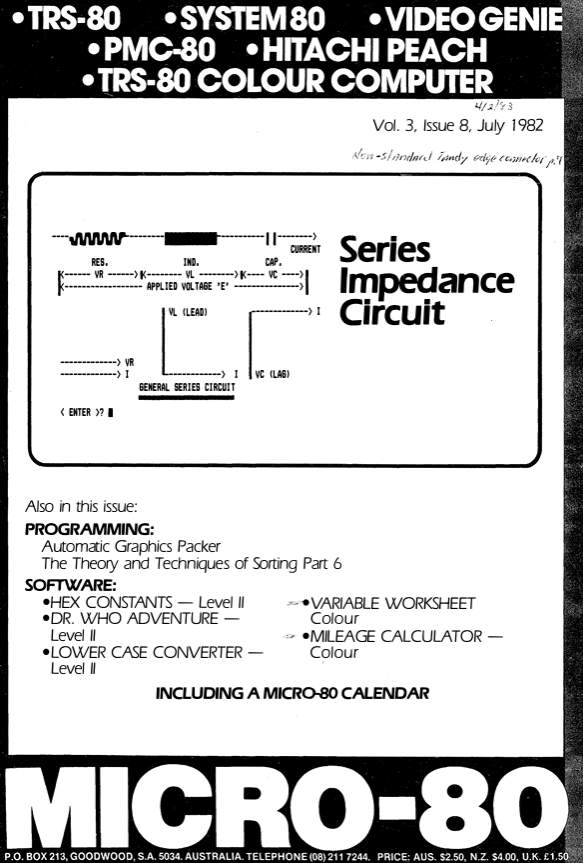
The source is for TRS-80 but I am playing Jim Gerrie’s edited version for TRS-80 MC-10. In his blog post about the game he mentions bug fixes, including one where you can get “mugged” for an object but it doesn’t fix your inventory count, meaning you eventually can hit your inventory limit with 0 items. He also made some random values a little nicer and I’m not that gung ho about authenticity when it simply is going to be pain.
You do not seem to be “The Doctor” but just “you” sent along on a TARDIS the Time Lords have managed to scrouge up. I assume you are a Different Time Lord.
After Dr. Who collected the Key to Time and defeated the Black Guardian, he received many praises and went on to greater things. The Key itself was again broken into its component pieces and scattered throughout the universe.
But the dark forces threaten, and in order to save the universe, the Timelords again need the Key. You have been chosen to go forth and locate it for them.
The Key of Time is from Tom Baker’s run, specifically starting with The Ribos Operation in 1978, where the Doctor is asked by the White Guardian to find the six segments of the Key, bringing balance to the universe. The main gimmick to note for our purposes is that the pieces of the key are disguised as other things; in the first serial, a lump of Jethrik crystal is the first part of the key.
X pieces of some item of power makes for an extremely common videogame plot, so it is not shocking James Smith picked up on this as a game device. Your job is to bounce around planets searching for the Key, given that the pieces will be disguised.
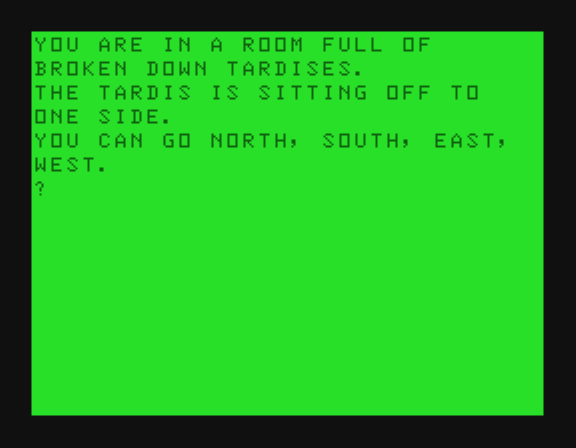
You start on Gallifrey. It is terribly easy to get lost, and at one intersection I got rammed by a passing TARDIS.

I did manage to find a “throne room” where the parts apparently get delivered after finding them.

However, upon exiting the throne room I got stuck in a series of junctions which I’m sure are a fairly simple maze, but since I didn’t have any objects yet I had to restart the game.

So I decided it was best to hop into the TARDIS and start time-hopping.
You will be given a TARDIS (rather old and unreliable, but the best available) that has the coordinates of the planets on which the six parts are located pre-programmed into it. By RESETing its controls you can travel between the six planets and Gallifrey. As usual, the six parts are disguised as other things, and you will have to use your intuition to figure out which is which. (There is a way to tell … )
All the planets are inhabited, and most inhabitants tend to be antisocial. Whether you TALK to them, HIDE from them, kill them, OFFER them gifts of appeasement, or simply ignore them is up to you. Most objects are obvious, but some are hidden and have to be SEARCHed for. Only one key part is on any one planet. Beware the maze on Peladon …
Of course, it was terrific that the first place I landed in an effort to avoid mazes was Peladon, the place of three moons and constant storms.
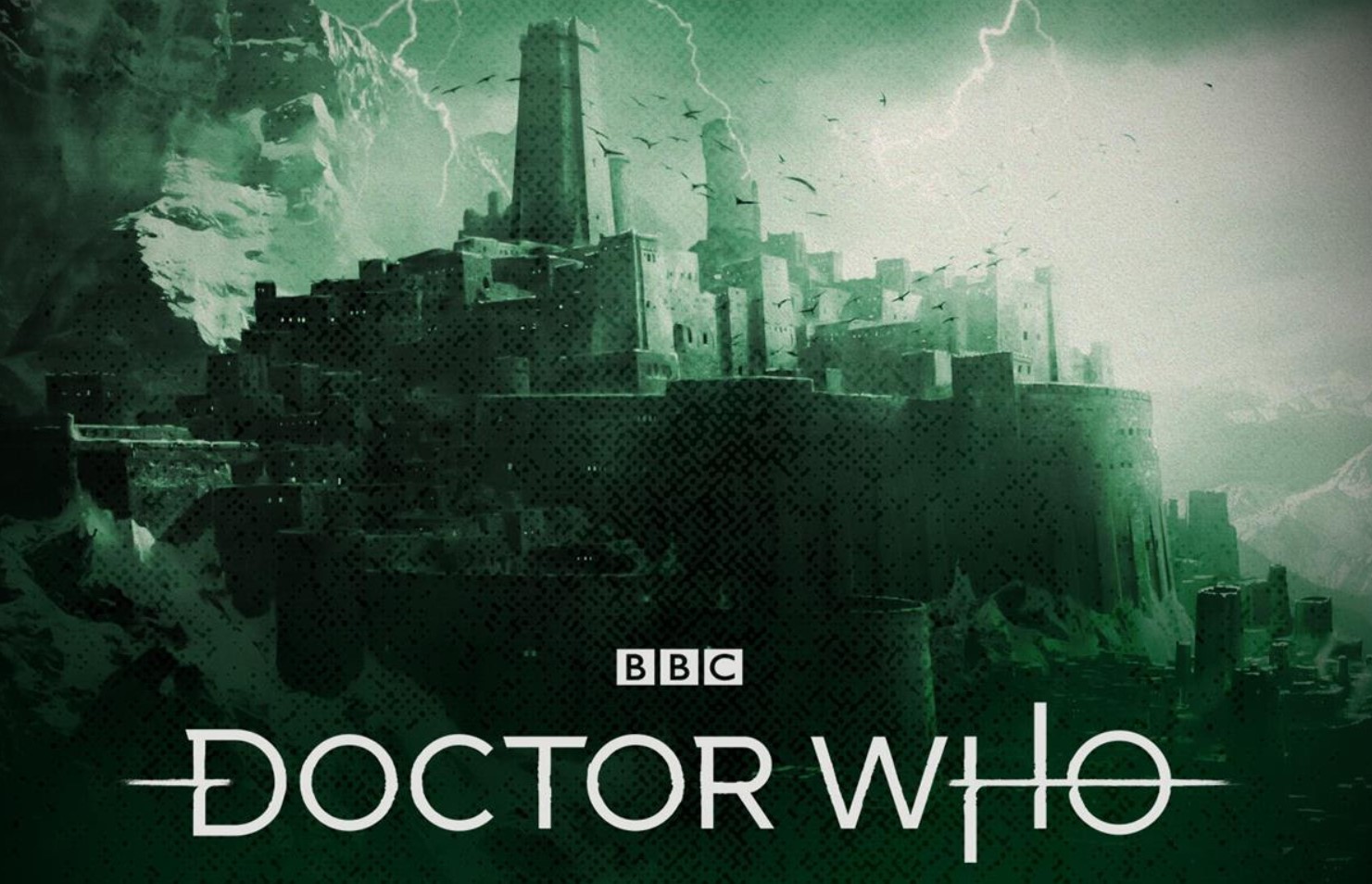
From a recent Big Finish series set on the planet. “Journey to Peladon, member world of the Galactic Federation and home to intrigue and adventure. With each passing generation, industrial exploitation and deadly political games are taking their toll on the planet.”
sigh Well, let’s try it. I stepped out to a trail, only to find some Peladonians coming nearby. As the instructions mentioned HIDE, I tried the verb out, landing me in the maze.

There was really nothing for me to try than wander randomly. I did hit some non-maze paths but quickly landed in the maze again. I eventually had to simply restart my game and go back to the planet from the TARDIS. This isn’t as easy as it sounds, since RESET from the TARDIS lands you on a random planet; you can’t choose.

The destinations are GALAFRY, SKARO, HIDAOUS, PELADON, DARK SIDE OF THE MOON, MUTOS, and DIETHYLAMIDE. You can also just end up in SPACE which in case it is simply another reset.
I wanted to be stubborn and finish what I could on Peladon, so I eventually got there after about twenty resets. The TARDIS incidentally comes with a limited number of resets in this game, and that number is intended to be random! (One of the values made nicer in the MC-10 port is making this random number of resets simply be the maximum from the range.)
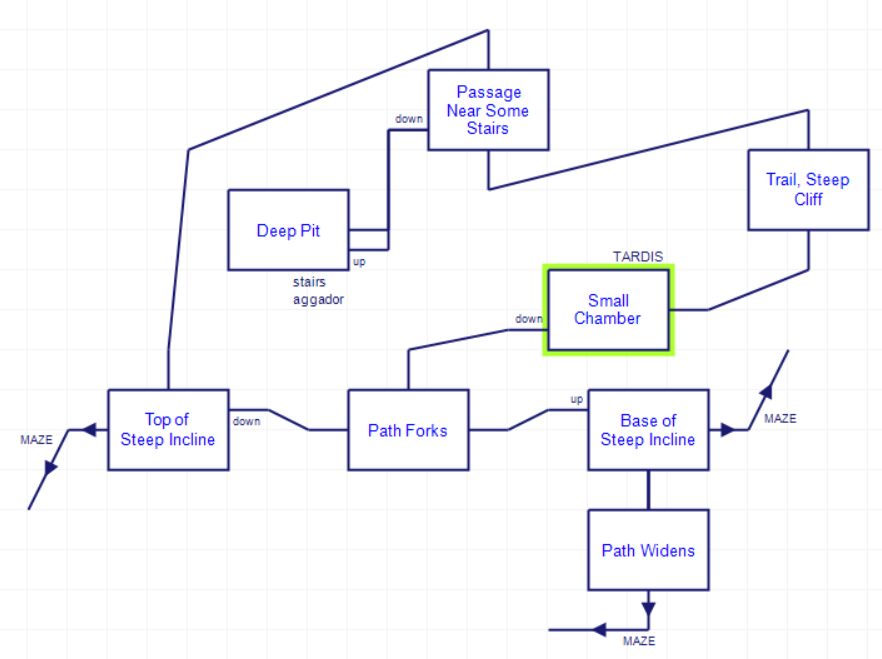
Even when not explicitly in the MAZE (as three of the exits go) the map is fairly maze-like and is the sort of game where if I go EAST from one room, I immediately need to test WEST back the other direction to see if it returns, since I’m likely to get a nasty surprise.
The wandering Peladonites turned out not to be a threat — I could just go somewhere else when they showed up — and the only other thing on the planet I managed to find is an Aggedor.
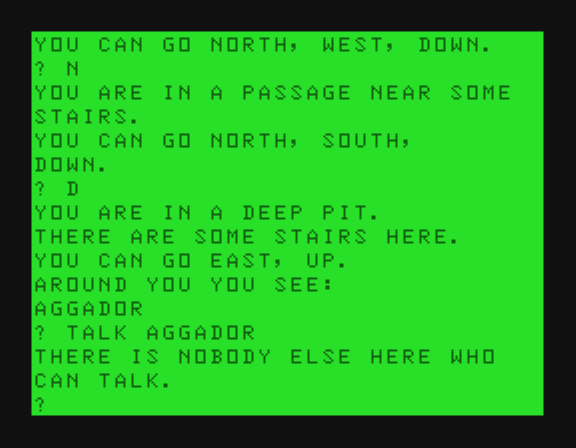
Perhaps I need to return with some music?

From the Alien Species Wiki: “The Aggedor is a wild beast native to the mountainous regions of planet Peladon … The ancient natives of Peladon viewed the Aggedor as a sacred animal and symbol of great power, to be feared and respected. The creatures can be domesticated and trained, and are susceptible to some kinds of music. The Doctor was once able to hypnotize one such beast with his watch while singing a Venusian lullaby.”
This game has been a hassle to get going, so I wanted to report in for now. Hopefully I’ll have visited all the different planets next time. I don’t think this is be like G.F.S Sorceress with a dense plot — this still is only a type-in with limited space — but at least the random elements (whatever they happen to be) should make for an interesting write-up, even if it turns out to be suffering on my part.
Of the first 253 episodes of Doctor Who broadcast between 1963 and 1969, 97 are missing. The BBC was always very good at wiping video tapes (in the early seventies it was mainly Ampex VR2000 2 inch tapes). They cost £300 at the time so you can see why they were often re-used.
Even more tragic was the fate of the first 12 years of Top of the Pops (1964-1976) where there are 503 missing episodes. They only stopped wiping them in February 1977. At least 1976 has 80 percent of its episodes intact. One (from 12 February 1976) was found in a skip during a house renovation. It hadn’t been played for 34 years and still runs perfectly. This was taped on a Philips N1500 video recorder.
https://www.youtube.com/watch?v=olnLnG4PcSQ&ab_channel=findaclip
One thing I find interesing is that the episodes which do survive often seem to be back-to-back broadcasts, i.e. consecutive weeks. My guess is the chief bean counter was on a fortnight’s holiday and an underling secreted the tapes away when he knew he wasn;’t being scrutinised.
I’m a Pink Floyd fan, but at least the weird distortions on this one just make it psychedelic.
I always liked Floyd but I preferred Gabriel-era Genesis.
I’ve managed to get hold of most of the episodes of Top of the Pops which the BBC has never repeated; they had never re-shown them at all until in April 2011 they finally began to put them on again via their new channel BBC4, starting for some arcane reason at April 1 1976. With a very few exceptions (one presented by Kenny Everett from October 11 1973 being an example) they have never re-shown the 1964-76 missing episodes to this day. Fortunately they flogged copies of the master tapes in the early days to various countries and Musik Laden has all the surviving episodes from the first twelve years in tip top condition, albeit with the presenters’ voices muted so the country in question could presumably add their own language over the top.
Irony of ironies when they did finally start repeating them the Jimmy Savile scandal broke and they withheld showing all the episodes that he presented, together with those of Dave Lee Travis. DLT ended up having to sell his house to pay for his legal fees. Some of it smacked of a kind of puritanical McCarthyism; certainly in his case. Operation Yewtree went bonkers as lots of BBC presenters from the 1970s were under suspicion.
The Beeb were going to wipe Monty Python’s Flying Circus too until the group were informed by a BBC insider and they managed to save them for posterity. Peter Cook and Dudley Moore weren’t so lucky.
‘The Key to Time’ has inspired the plot to the most “Doctor Who” text adventures; there are four, I think, based loosely on it. ‘The Five Doctors’ is probably the next most popular inspiration. I must go back and watch the Key to Time season as I was too young to remember the original broadcast. Like many, living in the time before repeats and videotapes, most of my “viewing” of early Doctor Who were through the Target novelisations. They were our videotapes.
There’s often lots of talk about “videogame preservation” and people bemoaning so much work is becoming lost and inaccessible, as though that’s something unique to the medium. Tales like those of the BBC archive just show we can be really bad at recognising the value of and preserving any art, whether its books, tv shows or movies.
In fairness to the Beeb they probably didn’t foresee modern technology at the time. Having said that I’d far rather their old frugality with my money than their modern Viv Nicholson style approach. Birt, Yentob and their ilk only seem to like the perpetuation of one part of our history – the licence fee. I’d have stripped them of their charter back in the nineties when some of their executives were caught leaving taxis running outside their favourite restaurants while they gorged themselves inside.
Something that’s quite alien to us modern folk is that for a lot of its existence, TV was thought of as being more akin to the stage than to, say, film. The idea of preserving individual TV episodes was as strange to them as imagining one could preserve one particular performance of a stageplay. If people wanted to see the play again in the future, we could just make it again. With currently-saleable actors and modern production values.
That’s also how film was considered at first, what with there not being a pre-existing concept of “a live performance that is preserved in a fixed, permanent form” – that’s why so much early film is lost. Hitchcock remade his own early films.
A lot of what survived of Doctor Who is still around because of copies made for international distribution. Contemporary shows without international distribution fared much worse. (This is probably why American TV from the same period is better preserved; the size of the US meant that a lot more physical copies needed to be made and shipped around the country)
I tried the game a little bit and looked at a walkthrough and I expect suffering on your part.
I am about halfway through my next post
It is putting up a fight for sure
The CASA walkthrough is also very unclear, at least on the problem I tried before giving up–I wound up source diving to find the solution. And am happy to leave the experience to you.
It seems like the game is very easy to soft lock:
V sbhaq zlfrys pbasebagrq jvgu fbzrguvat gung jbhyqa’g yrg zr rfpncr, gung gur tnzr jbhyqa’g yrg zr uvqr sebz orpnhfr vg jnfa’g pbqrq nf bar bs gubfr jnaqrevat vaunovgnag tebhcf, naq gung V arrqrq fbzrguvat sebz nabgure cynarg gb qrny jvgu. Juvpu vf cnegvphyneyl naablvat fvapr gur tnzr fraqf lbh gb cynargf va enaqbz beqre naq lbh unir yvzvgrq ergevrf.
is this referring to the spider?
When I say I had to source dive, I don’t mean that it’s something that you wouldn’t work out in the ordinary course of play, I just mean that the real solution wasn’t apparent from the walkthrough.
Sorry for the Syntax error. That version is a bit old (#3 versus #16). Here’s permalink to my latest distro: https://drive.google.com/file/d/11pXdOi8f4RvfvnD3NlCwaD3EMV-K7DGV/view?usp=sharing